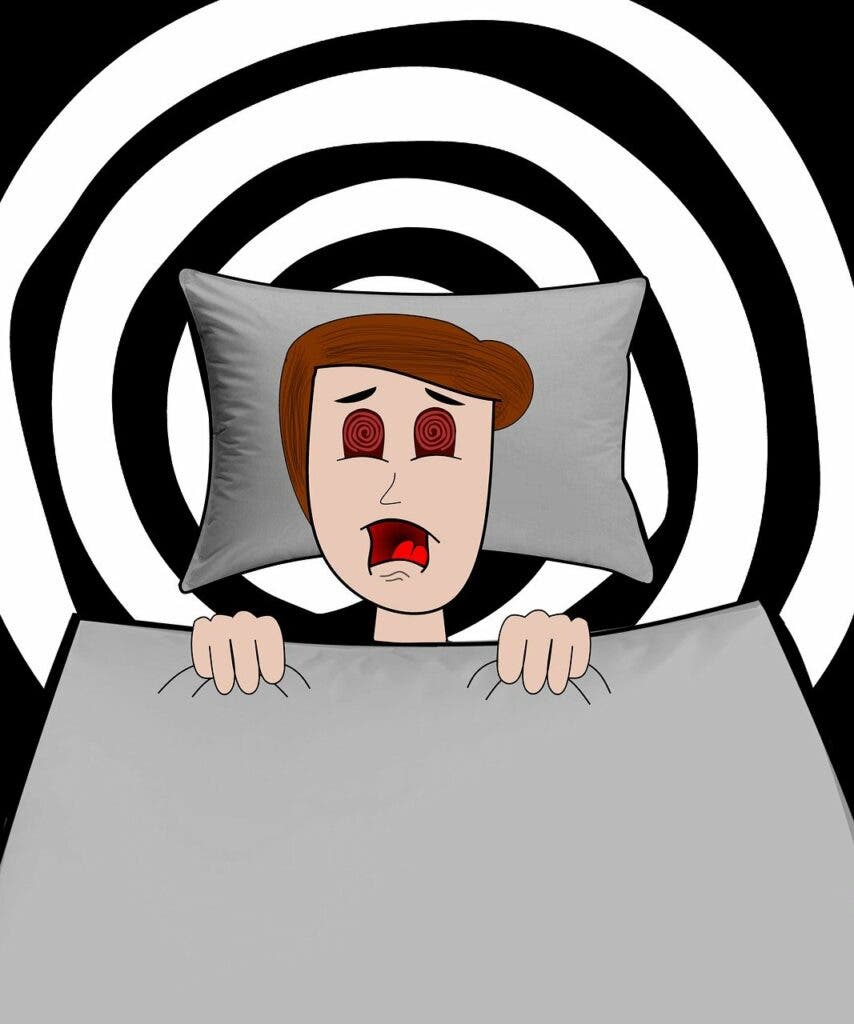
Imagine waking up in the middle of the night and not being able to move a finger, despite being fully aware of the surroundings. It can be a very distressing situation, and as the seconds tick by, the feeling of helplessness is only amplified. To make matters worse, this paralysis can be accompanied by the feeling that there’s a looming presence in the bedroom, which has sometimes been associated with ‘demons’. For this reason, sleep hallucinations are sometimes called the Incubus phenomenon.
But although this experience can be harrowing, sleep paralysis and sleep hallucinations (also known as sleep demons) are totally harmless. In the rare instances that they happen, they tend to occur right after you wake up or in the moments before you descend into full slumber. However, both are signs of sleep disruptions.
About one in ten people will experience at least one episode of sleep paralysis in their lifetimes. And since we have reports of symptoms of sleep paralysis going back centuries and across all cultures, we can safely assume that this odd phenomenon has always been part of the human experience.
Because sleep paralysis and hallucinations can be so frightening, people have always associated them with mystical experiences. However, we know better.
What is sleep paralysis
Sleep paralysis is temporary and happens as a result of a malfunction in the rapid eye movement (REM) phase of sleep, a cycle during which the brain is very active. During REM, the eyes dart around quickly, and pulse, blood pressure, and breathing speed up.
When we’re in REM sleep, which is triggered about 90 minutes after falling asleep, the arm and leg muscles become temporarily paralyzed. This is actually very useful since it is also during REM that we dream. If our limbs weren’t paralyzed, we’d act out on our dreams, which could prove dangerous to both ourselves and anyone lying beside us.
Basically, every night our body becomes paralyzed and that’s totally normal. The problem with sleep paralysis is it happens while we’re perfectly aware of our surroundings rather than being oblivious to the fact during slumber. This disruption can occur when transitioning between REM sleep and waking. Your mind is becoming aware you’re not asleep anymore, but the REM paralysis just hasn’t subsided yet.
And since REM sleep is also the time when we dream, disruptions to this critical sleep cycle may temporarily cause you to essentially dream with your eyes wide open. The dream-like state that creeps into wakefulness can cause hallucinations, turning your room into a dungeon or your cat into a goblin. These hallucinations don’t necessarily have to be visual. Some experience tactile, kinetic, olfactory, or auditory hallucinations. For instance, the unsettling feeling that someone’s in the same room with you is a kinetic hallucination.
Intruder hallucinations are often accompanied by sensing pressure on the thorax, anxiety, and a feeling of suffocation.
Sleep paralysis tends to occur either when you are falling asleep (predormital sleep paralysis) or as you’re waking up (postdormital sleep paralysis). While postdormital paralysis is associated with REM disruption, predormital sleep paralysis is owed to staying aware while falling asleep.
Whilst sleep paralysis and sleep hallucinations tend to happen separately, they can sometimes occur together much to the horror of those unfortunate enough to experience this combo.
What causes sleep paralysis
The consensus is that sleep paralysis is the result of disrupted REM sleep. If this happens to you, it’s a sign that your body isn’t going through the stages of sleep properly.
“The usual phase of the sleep cycle in which it manifests is the REM sleep phase. During Non-REM sleep, there is an increase in parasympathetic tone and a decrease in sympathetic tone, while during phasic REM sleep, there are surges in sympathetic tone. It prevents movement of body parts in response to the dreams and muscles of the body become paralyzed temporarily. If the patient achieves wakefulness in this state, it creates the dissociation between perception and motor control that is characteristic of sleep paralysis,” write researchers Maheen Farooq and Fatima Anjum in a study that reviews the literature on sleep paralysis.
Sleep paralysis may be due to lack of sleep, sudden changes in your sleep schedule, certain conditions such as narcolepsy (excessive sleepiness) or nighttime leg cramps, as well as stress or bipolar disorder. Certain medications, such as those for ADHD, or drug abuse may also trigger sleep paralysis.
“No studies have demonstrated any long-term consequences on the health of patients who experience sleep paralysis. While the underlying risk factors may contribute to health-related issues later in life, for example, anxiety poses a risk for hypertension; there is no reported independent association. The episodes of sleep paralysis reportedly come in ‘waves,’ and the prognosis is good if the triggers are managed effectively in most cases,” the researchers added.
Sleep paralysis is the vast majority of cases not a cause for concern and does not require treatment. However, if the phenomenon is triggered by narcolepsy or some other underlying condition, a doctor may recommend clocking in more hours of sleep per night, using antidepressant medication, or beginning therapy to address any mental health problems. Sometimes doing something as simple as changing sleep positions if you sleep on your back can keep sleep paralysis at bay.
It’s also worth looking into our bedtime routine as whatever activities you engage in 1-2 hours before going to sleep can have a dramatic impact on the quality of your sleep.
Bottom line: sleep paralysis is generally harmless and is caused by disruption to sleep, although in some cases it may be associated with underlying chronic sleep disorders and mental health problems. There’s no need to fear demons or alien abductors when you know it’s just your mind playing tricks on you and it will all go away by itself within moments.


